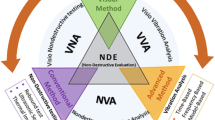Abstract
Optimization of vibrating structures by means of finite element models usually requires a high number of optimization runs, where the finite element analysis time itself is often already a serious issue. The total optimization time consists of the finite element (FE) analysis calculation time multiplied by the number of optimization iterations. In this paper a computationally efficient strategy for optimization of structures is presented. Transmissibility functions are introduced to speed-up the FE analysis step, making use of the modal model. The method demonstrates it usefulness in the case of random response analysis where the external loading types are defined statistically by means of power spectral density functions. The relationship between random response displacement power spectral density and input base acceleration power spectral density is written in terms of a transmissibility function between response and excitation. An important feature of the presented method is its numerical efficiency with respect to calculation times. A comparison will be made with existing methods available in commercial FE software. The effectiveness of the proposed procedure is illustrated by means of a case study.
Similar content being viewed by others
References
Abaqus (2006) Random response analysis. In: ABAQUS theory manual version 6.6, Hibbit, Karlsson and Sorensen, Pawtucket, chap 2.5.8
Ansys Inc (2007) Ansys release 10.0 commands reference
Bathe KJ (1996) Finite element procedures. Prentice Hall, Englewood Cliffs
Bös J (2006) Numerical optimization of the thickness distribution of three-dimensional structures with respect to their structural acoustic properties. Struct Multidisc Optim 32:12–30
Breitkopf P, Naceur H, Rassineux A, Villon P (2005) Moving least squares response surface approximation: formulation and metal forming applications. Comput Struct 83:1411–1428
Bucher I (2002) Parametric optimization of structures under combined base motion direct forces and static loading. J Vib Acoust 124:132–140
Bucher I, Braun S (1994a) Efficient optimization procedure for minimizing vibratory response via redesign or modification, part i: theory. J Sound Vib 175(4):433–453
Bucher I, Braun S (1994b) Efficient optimization procedure for minimizing vibratory response via redesign or modification, part ii: examples. J Sound Vib 175(4):455–473
Ewins D (1986a) Random vibration. In: Modal testing: theory and practice. Research Studies, Letchworth, pp 79–82
Ewins D (1986b) Theoretical basis. In: Modal testing: theory and practice. Research Studies, Letchworth, pp 19–82
Feng F, Kim Y, Yang B (2006) Applications of hybrid optimization techniques for model updating of rotor shafts. Struct Multidisc Optim 32:65–75
Friswell MI, Mottershead JE (1999) Finite element model updating in structural dynamics. Kluwer Academic, Dordrecht
Fritzen CP, Jennewein D, Kiefer T (1998) Damage detection based on model updating methods. Mech Syst Signal Process 12(1):163–186
Göge D, Link M (2002) Experience with different residuals for updating and validating finite element models using test data from two structural configurations. In: Proceedings of the international conference on structural dynamics modelling, Madeira Island, June 2002
Groenwold A, Etman L, Snyman J, Rooda J (2007) Incomplete series expansion for function approximation. Struct Multidisc Optim 34:21–40
Guillaume P, Devriendt C, De Sitter G (2005) Identification of modal parameters from transmissibility measurements. In: Proceedings of the 1st international operational modal analysis conference, Copenhagen, 26–27 April 2005
Heylen W, Lammens S, Sas P, Van der Auweraer H (1997) Modal analysis theory and testing. Katholieke Universiteit Leuven, Departement Werktuigkunde, Leuven
Hwang K, Lee K, Park G (2001) Robust optimization of an automobile rearview mirror for vibration reduction. Struct Multidisc Optim 21:300–308
Kiasat A, Moradi M, Hashemolhosseini H (2007) Investigation of the influence of the parameters affecting the accuracy of the moving least square approximation. In: Proceedings of the Eleventh international conference on civil, structural and environmental engineering computing, Malta, 18–21 September 2007
Kitis L, Wang B, Pilkey W (1983) Vibration reduction over a frequency range. J Sound Vib 89(4):559–569
Levin D (1998) The approximation power of moving least-squares. Math Comput 67(224):1517–1531
Lopez-Roldan J, Devriendt C, Enns J, Gijs R, Guillaume P (2008) How to achieve a rapid deployment of mobile substations and to guarantee its integrity during transport. IEEE Trans Power Deliv 23:196–202
Maia NMM, Silva JMM (1997) Theoretical and experimental modal analysis. Research Studies (ISBN 0863802087), Hertfordshire
Rade D, Steffen V (2000) Optimization of dynamic vibration absorbers over a frequency band. Mech Syst Signal Process 14(5):679–690
Rao SS (1996) Engineering optimization—theory and practice, 3rd edn. Wiley, New York
Ribeiro A, Silva J, Maia N (2000) On the generalisation of the transmissibility concept. Mech Syst Signal Process 14:29–35
Steenackers G, Guillaume P (2006) Finite element model updating taking into account the uncertainty on the modal parameters estimates. J Sound Vib 296:919–934
Steenackers G, Devriendt C, Guillaume P (2007) On the use of transmissibility measurements for finite element model updating. J Sound Vib 303:707–722
Strauß F, Inagaki M, Starke J (2007) Reduction of vibration level in rotordynamics by design optimization. Struct Multidisc Optim 34:139–149
Sweitzer K, Bishop N, Genberg V (2004) Efficient computation of spectral moments for determination of random response statistics. In: Proceedings of the 29rd international seminar on modal analysis (ISMA23), Leuven, September 2004
The MathWorks (2004) Matlab optimization toolbox user’s guide
Thorby D (2007) Structural dynamics and vibration in practice: an engineering handbook. Butterworth Heinemann, Boston
Toropov V, Filatov A, Polynkin A (1993) Multiparameter structural optimization using fem and multipoint explicit approximations. Struct Optim 6:7–14
Wirsching PH, Paez TL, Ortiz K (1995) Random vibrations: theory and practice. Wiley-Interscience, New York
Zienkiewicz OC, Taylor RL (2000) The finite element method, 5th edn., vol.1: the basis. Butterworth-Heinemann, Oxford
Author information
Authors and Affiliations
Corresponding author
Rights and permissions
About this article
Cite this article
Steenackers, G., Guillaume, P. & Vanlanduit, S. Development of a regressive finite element model optimization technique making use of transmissibilities. Struct Multidisc Optim 39, 47–62 (2009). https://doi.org/10.1007/s00158-008-0313-9
Received:
Revised:
Accepted:
Published:
Issue Date:
DOI: https://doi.org/10.1007/s00158-008-0313-9




